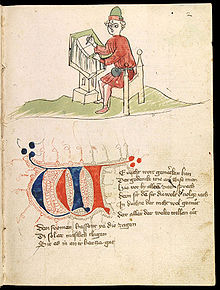| Lanzelet | |
|---|---|
| by Ulrich von Zatzikhoven | |
 Ulrich von Zatzikhoven and the first lines of Lanzelet in the Manuscript of Heidelberg | |
| Written | after 1194 |
| Language | Middle High German |
| Subject(s) | Arthurian legend |
| Genre(s) | Chivalric romance |
| Lines | 9,400 |
This article's lead section may be too long. (June 2018) |
Lanzelet is a medieval romance written by Ulrich von Zatzikhoven after 1194. It is the first treatment of the Lancelot tradition in German, and contains the earliest known account of the hero's childhood with the Lady of the Lake-like figure in any language. The poem consists of about 9,400 lines arranged in 4-stressed Middle High German couplets. It survives complete in two manuscripts[1] and in fragmentary form in three others.[2]
The author is often identified with a Swiss cleric named in a document from 1214, though little else is known of him. He claims he translated Lanzelet from a welschez (Middle High German for French, but in this case probably Anglo-Norman) book brought to Germany by Hugo de Morville, one of the Crusaders who replaced Richard the Lionhearted as a hostage when the king had been arrested by Leopold V, Duke of Austria in 1194.
The poem features a version of the hero's childhood, including the death of his father Pant (Ban) and his upbringing by a water fay, that is similar to that contained in the Prose Lancelot and mentioned in Chrétien de Troyes' Lancelot, the Knight of the Cart, but it deviates very strikingly from the familiar version of Lancelot's life in other respects. The most notable among these is the absence of the hero's famous love affair with Arthur's wife Guinevere; when Ginover (Guinevere) is abducted by King Valerin it is not Lanzelet who rescues her, and Lanzelet eventually finds love elsewhere with a young princess named Iblis. It has been suggested that Lancelot, who is mentioned for the first time by Chrétien de Troyes in his first romance Erec and Enide, was originally the hero of a story independent of the adulterous love triangle and perhaps very similar to Ulrich's version. If this is true, then the adultury facet would have been added either by Chrétien in Knight of the Cart or the source provided him by his patron, Marie de Champagne.
Though Lanzelet has never received the attention garnered by the romances of Hartmann von Aue, Gottfried von Strassburg, or Wolfram von Eschenbach, it was not forgotten by subsequent German authors. Heinrich von dem Türlin included elements of Lanzelet into his Grail romance Diu Crône, and Rudolf von Ems praised Ulrich in two of his works, Willehalm[3] and the Alexanderroman.[4]
- ^ W, 13th century; and P, 1420. From Schultz, James A. (1991). "Ulrich von Zatzikhoven". In Norris J. Lacy, The New Arthurian Encyclopedia, pp. 481–482. New York: Garland. ISBN 0-8240-4377-4.
- ^ B, early 13th century; G and S, 14th century. From Schultz, "Ulrich von Zatzikhoven".
- ^ Line 2,197. From Schultz, "Ulrich von Zatzikhoven".
- ^ Line 3,199. From Schultz, "Ulrich von Zatzikhoven".
© MMXXIII Rich X Search. We shall prevail. All rights reserved. Rich X Search
